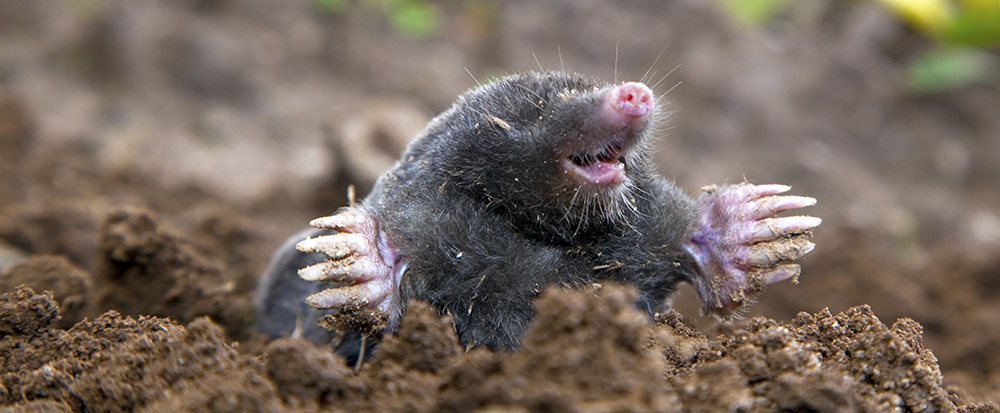
protect your garden from
moles, voles, and Gophers

protect your garden from
moles, voles, and Gophers

Protect Your Garden From
moles, voles, and Gophers
Contents
CONTROL MOLES, VOLES, AND GOPHERS, WITH THESE ECO-FRIENDLY Products
BARRIERS
MOLES
Amdro Mole, Vole and Gopher Blocker wire
VOLES
Amdro Mole, Vole and Gopher Blocker wire • Gonzo Gopher Shield
GOPHERS
Amdro Mole, Vole and Gopher Blocker wire • Diggers Root Guard Baskets and Wire • Gonzo Gopher Shield
REPELLENTS
MOLES
Bonide Mole Max • Bonide Gopher Max • Liquid Fence Mole Repellent • Liquid Fence Mole and Vole Repellent • Messina Wildlife Mole and Vole Stopper • Mole Scram • Ortho Mole B Gone Mole and Vole Repellent • Repellex Mole, Vole, & Gopher Repellent • Sweeneys Mole and Gopher Repellent • Tom Cat Mole and Gopher Repellent
VOLES
Bonide Mole Max • Bonide Gopher Max • Liquid Fence Mole and Vole Repellent • Messina Wildlife Mole and Vole Stopper • Ortho Mole B Gone Mole and Vole Repellent • Repellex Mole, Vole, & Gopher Repellent • Sweeneys Mole and Gopher Repellent • Tom Cat Mole and Gopher Repellent • Vole Scram
GOPHERS
Bonide Mole Max • Bonide Gopher Max • Gopher Scram • Repellex Mole, Vole, & Gopher Repellent • Sweeneys Mole and Gopher Repellent • Tom Cat Mole and Gopher Repellent
TRAPS
MOLES
Amdro Multi-use Traps • Cinch Trap for Moles • Gonzo Dead End Mole and Gopher Trap • Sweeney’s Mole Trap • Tom Cat Mole Trap, Victor Mole Trap
VOLES
Snap-style mouse traps, such as Victor or Tom Cat
GOPHERS
Amdro Multi-use Traps • Black Hole Gopher Trap • Cinch Trap for Gophers • Gophinator • Gopher Hawk • Gonzo Dead End Mole and Gopher Trap • Macabee Gopher Trap • Revenge Gopher Trap • Sweeney’s Gopher Trap • Victor Black Box • Victor Gopher Trap • Wilco Trap for Gophers
MOLES
VOLES
GOPHERS
BARRIERS
Amdro Mole, Vole and Gopher Blocker wire
Amdro Mole, Vole and Gopher Blocker wire • Gonzo Gopher Shield
Amdro Mole, Vole and Gopher Blocker wire • Diggers Root Guard Baskets and Wire • Gonzo Gopher Shield
REPELLENTS
Bonide Mole Max • Bonide Gopher Max • Liquid Fence Mole Repellent • Liquid Fence Mole and Vole Repellent • Messina Wildlife Mole and Vole Stopper • Mole Scram • Ortho Mole B Gone Mole and Vole Repellent • Repellex Mole, Vole, & Gopher Repellent • Sweeneys Mole and Gopher Repellent • Tom Cat Mole and Gopher Repellent
Bonide Mole Max • Bonide Gopher Max • Liquid Fence Mole and Vole Repellent • Messina Wildlife Mole and Vole Stopper • Ortho Mole B Gone Mole and Vole Repellent • Repellex Mole, Vole, & Gopher Repellent • Sweeneys Mole and Gopher Repellent • Tom Cat Mole and Gopher Repellent • Vole Scram
Bonide Mole Max • Bonide Gopher Max • Gopher Scram • Repellex Mole, Vole, & Gopher Repellent • Sweeneys Mole and Gopher Repellent • Tom Cat Mole and Gopher Repellent
TRAPS
Amdro Multi-use Traps • Cinch Trap for Moles • Gonzo Dead End Mole and Gopher Trap • Sweeney’s Mole Trap • Tom Cat Mole Trap, Victor Mole Trap
Snap-style mouse traps, such as Victor or Tom Cat
Amdro Multi-use Traps • Black Hole Gopher Trap • Cinch Trap for Gophers • Gophinator • Gopher Hawk • Gonzo Dead End Mole and Gopher Trap • Macabee Gopher Trap • Revenge Gopher Trap • Sweeney’s Gopher Trap • Victor Black Box • Victor Gopher Trap • Wilco Trap for Gophers
MOLE, VOLE, OR GOPHER? HOW DO I KNOW?
- If you see cone-shaped mounds of soil or a network of raised tunnels, and your plants are not getting eaten, you likely have moles.
- If you see a network of closed or partly exposed tunnels (runways) and a clean, golf ball-sized entrance hole to a tunnel, you likely have voles. Locate the runways by moving aside groundcover.
- If you see a crescent-shaped mound of soil with a plugged opening, you likely have gophers. A gopher will plug any opening to its burrow system.

Something is tearing up your garden. Varmints! But what kind?
In most parts of California, the likely culprits are moles, voles, or pocket gophers. All are controllable with non-toxic strategies, combined with accurate pest identification, determination, and perseverance.
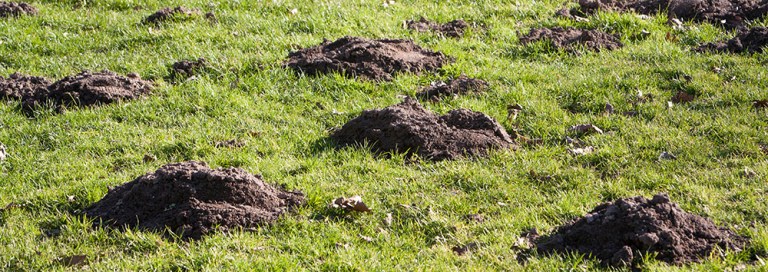
Know Your Target Pest!
Moles
Moles (Scapanus species) are small mammals (4 to 7 inches long) that eat grubs, other insects, and earthworms. With oversized front claws, sensitive snouts, and poor eyesight, moles are adapted to life underground and are terrific diggers. In a single day, a mole can crisscross a lawn with 150 feet of tunnels, and shallow feeding runs. Moles are most active after rain or irrigation when the soil is easy to work; they are less active during very hot or very cold weather, or during drought. Moles are solitary animals except during the breeding season (late winter to early spring).

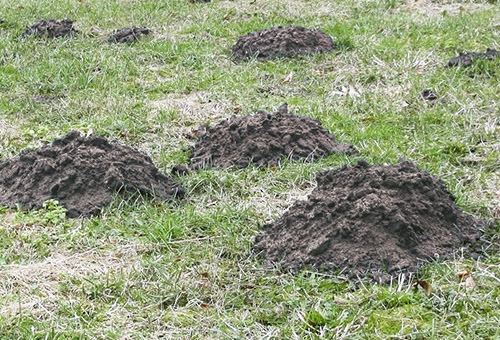
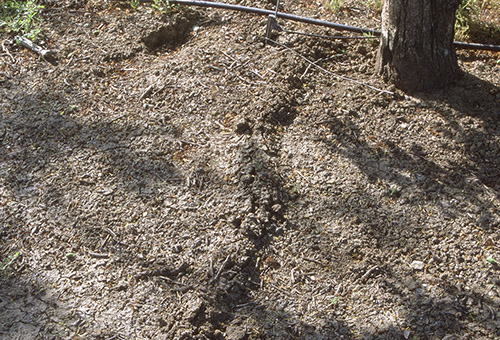
Moles
Moles (Scapanus species) are small mammals (4 to 7 inches long) that eat grubs, other insects, and earthworms. With oversized front claws, sensitive snouts, and poor eyesight, moles are adapted to life underground and are terrific diggers. In a single day, a mole can crisscross a lawn with 150 feet of tunnels, and shallow feeding runs. Moles are most active after rain or irrigation when the soil is easy to work; they are less active during very hot or very cold weather, or during drought. Moles are solitary animals except during the breeding season (late winter to early spring).



Voles
Voles (meadow mice) are rodents with short tails and round bodies. In California, we have six species of voles from the genus Microtus. The California vole (M. californicus) and the montane vole (M. montanus) are the most common garden pests in our state. Adult voles are 5 to 8 inches long, including the tail. Vole populations can be cyclical, which means that their numbers can spike to several thousand per acre in a short time. If you think you have voles, it’s important to get them under control quickly.
Voles are vegetarians, feeding on grasses, vegetables, herbaceous plants, bulbs, tubers, tree roots, and bark. Unlike moles and gophers, they’re not diggers, so they often take over abandoned gopher or mole burrows.

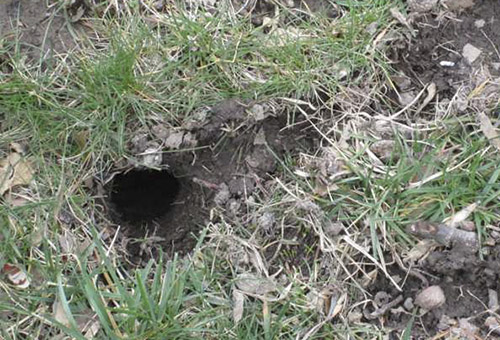
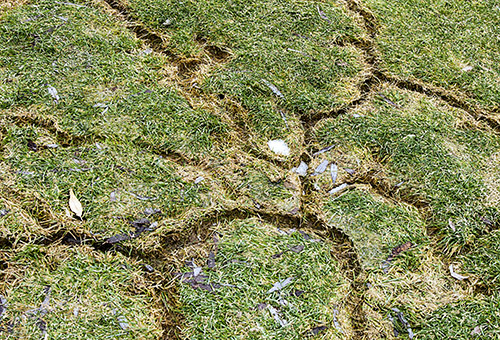
Pocket Gophers
Pocket gophers (Thomomys species) are so called because they carry food and nesting material in furry cheek pouches. Gophers are larger than moles or voles—about 6 to 10 inches long, and have large yellow-orange front teeth and small eyes and ears. Like voles, they are plant eaters, preferring roots and the fleshy underground portion of plants. They’re very busy under ground—a gopher’s burrow system can cover an area 200 to 2,000 feet square. A typical system includes feeding tunnels 6 to 12 inches below the surface, and nesting and food storage chambers as deep as 6 feet.

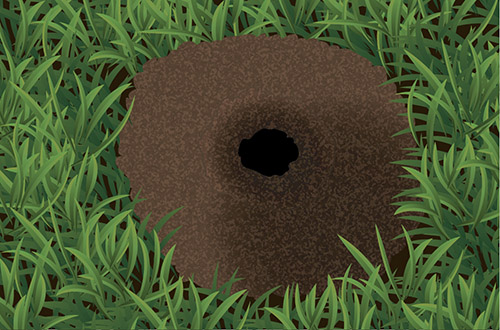

Controlling Burrowing Critters
The less-toxic, more humane, and generally safer methods of control are barriers, which keep them away from your plants, and trapping. Castor oil-based repellents may be effective temporarily, but are not as effective as barriers or traps.
The Our Water Our World Program doesn’t recommend poisons, fumigants, or incendiary devices to control moles, voles, or gophers.
Barriers: Protect your plants from voles and gophers
- Remove weeds and other plant material to help discourage voles, which are attracted to dense foliage where they can hide from owls, hawks, and other predators.
- For voles, bury ¼-inch wire mesh 6 to 10 inches below the surface, extending 12 inches above ground, to keep the animals from tunneling in. A cleared area outside the barrier provides extra protection.
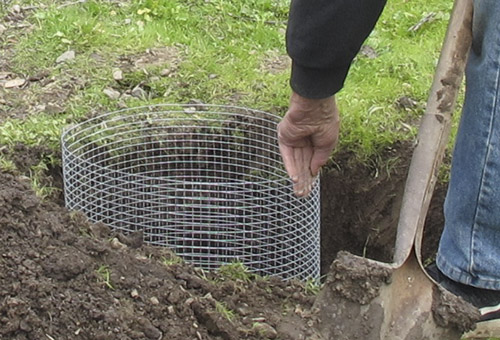
- For gophers, install ¼-inch wire mesh at least 2 feet deep with at least 1 feet extending above ground, bent back away from the planting area you are protecting. This approach is not foolproof, though, as gophers are talented and motivated diggers.
- Plant tender plants in wire “gopher baskets.” Be sure to choose a basket large enough to allow room for root growth, and leave a few inches of mesh above the ground.
- For new raised planter beds, cover the entire bottom of the box with half-inch hardware cloth or gopher wire before adding soil. For existing raised beds, remove soil down to 14 to 18 inches and lay ¼-inch wire mesh across the entire bottom and up the inside walls of the bed. Secure with fencing nails.
Barriers: Protect your plants from voles and gophers
- Remove weeds and other plant material to help discourage voles, which are attracted to dense foliage where they can hide from owls, hawks, and other predators.
- For voles, bury ¼-inch wire mesh 6 to 10 inches below the surface, extending 12 inches above ground, to keep the animals from tunneling in. A cleared area outside the barrier provides extra protection.
- For gophers, install ¼-inch wire mesh at least 2 feet deep with at least 1 feet extending above ground, bent back away from the planting area you are protecting. This approach is not foolproof, though, as gophers are talented and motivated diggers.

- Plant tender plants in wire “gopher baskets.” Be sure to choose a basket large enough to allow room for root growth, and leave a few inches of mesh above the ground.
- For new raised planter beds, cover the entire bottom of the box with half-inch hardware cloth or gopher wire before adding soil. For existing raised beds, remove soil down to 14 to 18 inches and lay ¼-inch wire mesh across the entire bottom and up the inside walls of the bed. Secure with fencing nails.
Trapping moles, voles, and gophers
Call a professional if you plan to trap burrowing pests. Traps can be dangerous! They must be set properly and placed where they won’t harm children or pets. If you call a professional, be sure to ask them not to use poison baits or fumigants.
If you plan to do it yourself, first identify the pest correctly and use a trap that is specific to moles, voles, and gophers. Be sure to follow the instructions on the label, in the packaging, or on the manufacturer’s website. Set traps in places where children or pets won’t dig them up.
For More Information
Many thanks to the University of California Statewide Integrated Pest Management Program for their excellent Pest Notes, from which we have borrowed much content!

